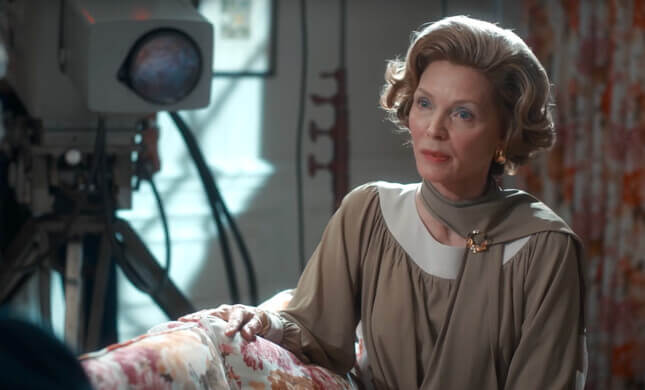‘The First Lady’ Finally Puts Betty Ford’s ‘Dramatic’ Life in the Spotlight
Apologies to Michelle Obama and Eleanor Roosevelt, but Michelle Pfeiffer's Ford runs away with the new Showtime series.
EntertainmentTV

Michelle Obama, Eleanor Roosevelt, and Betty Ford: One of these ladies is not quite like the others. It’s not just because she’s the Republican on the list—Ford, who spent only 895 days in the White House, just doesn’t have the same prominence in American cultural memory as the history-making, two-term, and still-prominent Obama, or Roosevelt, who served for 12 years and reshaped the nation’s idea of what a president’s wife could accomplish. So it might come as a slight surprise that despite (or perhaps because of) her lower profile, Betty Ford’s story is by far the best part of Showtime’s new series, The First Lady.
The show, which debuts Sunday, stars Viola Davis as Obama, Gillian Anderson as Roosevelt, and Michelle Pfeiffer as Ford. Despite its subjects’ richness, in charting the lives of the three women at its center, the series treats them with a dull reverence that flattens them into history book heroines rather than bringing them to life. Still, the show’s treatment of Ford shines in a way that the other two first ladies’ storylines just don’t pull off. Eleanor Roosevelt has been portrayed by dozens of actresses across countless films and TV projects, from Annie to Warm Springs. “Michelle Obama” isn’t quite as common an IMDb credit yet, but she’s, you know, very much alive, regularly in the news, and still actively building her own legacy. Outside of the 1987 TV movie The Betty Ford Story—which isn’t exactly streaming on Netflix—Ford hasn’t become a pop culture staple. This means that, unlike the other figures at the heart of The First Lady, the show has the opportunity to do something novel with Betty Ford: Introduce her to a new generation.
Ford was born Elizabeth Bloomer in 1918, and spent her early years training for a career as a dancer. In 1938, she left her hometown of Grand Rapids, Michigan, to pursue her modern dance dreams with Martha Graham’s New York City-based company. “The idea of a young Midwestern woman striking out on this very independent career in the arts as a dancer,” first ladies expert and Ohio University professor Katherine Jellison told Jezebel. “I would say that most Michiganders of her generation probably thought that was a very daring and outside the box thing for her to do.
Once back home in Michigan, Ford married and divorced one of her local suitors. To this day, she remains one of only two divorcée first ladies. (Florence Harding beat her to being the first.) Ford’s memoirs suggest that her first husband may have been an alcoholic, and he slipped into a diabetic coma just as she was on the verge of serving him divorce papers. When he recovered, a full two years later, she called it quits. According to Lisa McCubbins’ biography of Ford, she’d later call that chapter in her life the “five-year misunderstanding.” Soon after, she married local football hero Gerald Ford. He’d go on to embark on a career in Congress, while she became a political wife and raised the couple’s four children until the Watergate scandal propelled the family into the White House.

In the Showtime series, Ford, by then in her 90s, writes a note to Obama soon after the 2009 inauguration. “First ladies and their teams are often the vanguards of social progress in this country,” Ford’s on-screen letter reads. (It does seem that the real-life Ford sent Obama a congratulatory missive, but I’ve not been able to track down what exactly the note included.) In any case, the idea that the first lady represents the leading edge of American progress, is, well, just wrong. In fact, first ladies are generally held to more regressive standards than other women. In an interview with Jezebel, Connecticut College professor and The Politics of the President’s Wife author MaryAnne Borrelli quoted the historian Lewis Gould, who observed that First Ladies are “a lagging indicator.”
-

-

-

-

-

-

-

-

-

-

-

-

-

-

-

-

-

-

-

-

-

-

-

-

-

-

-

-

-

-

-

-

-

-

-

-

-

-

-

-








































